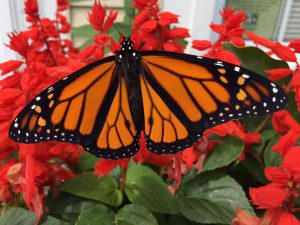Magical Monarchs
Sara Scussell, Chris Becher and Julie Champion – Metroparks Interpreters

There’s a delicate insect living right here in Michigan that makes an incredible 2,500 mile journey every year just to survive. This species at risk of becoming an “endangered species” but quietly pollinates our native plants every year. Do you know what it is? It’s the Monarch Butterfly!
The beloved orange and black Monarch butterflies arrive in late May on faded wings, having never before set their eyes upon Southeast Michigan. These butterflies’ grandparents departed from our Michigan shores last September, and as September nears, the journey from summer breeding grounds in the north to overwintering grounds in Mexico will begin again with this new generation of Monarch butterflies.
The survival of the Monarch butterfly is an intricate process for such a delicate insect. Butterflies use sight as well as “taste” through special organs on their feet to locate milkweed, the only host plant for the Monarch caterpillar. Milkweed grows wild in Southeast Michigan, and like its name suggests, it tends to pop up everywhere, “like a weed”. Corn fields, roadsides, and public parks are just a few of the favored habitats for these plants. Unfortunately, Monarch populations have been deeply affected by a critical lack of their host plant. The introduction of herbicide-resistant corn and soybeans in the 1990’s led to a loss of milkweed from agricultural fields, and in turn a steep decline of the Monarch butterfly population. In addition, researchers from the University of Minnesota are studying the effect road salt may be having on caterpillars that feed on milkweed along main highways.
For butterflies that are lucky enough to emerge successfully from a bejeweled green chrysalis, more difficult times lie ahead. Monarch butterflies are unable to survive Michigan’s winter weather, so for the last generation of Monarchs of the breeding season, survival means a long journey south. On their journey south, these butterflies can fly as much as 50-100 miles per day. Warm weather and good air currents aid their travels, and on cooler nights they cluster together to rest. Huge numbers of butterflies can be seen in the fall at Point Pelee National Park in Ontario, Canada, and occasionally at Huron Pointe in our very own Lake St. Clair Metropark. Traveling as a group, they cluster on peninsulas to find the shortest route over the open water and where they wait for favorable conditions before crossing.
A two-month journey of almost 2,500 miles will take these colorful insects to a unique habitat in the Sierra Madre Mountains of Mexico where they will find the best conditions for a chance at winter survival. Here the Oyamel Fir trees which grow two miles above sea level, provide habitat for the butterflies and help create a climate that is warm enough to prevent the butterflies from freezing, but cool enough to prevent them from using up the valuable fat resources that they have stored in their bodies.
In March, these wintering Monarchs begin to fly back north, stopping in Texas and other southern states to mate and lay eggs. Females will lay up to 300 eggs along the way, only on milkweed plants, and it may take several life-cycles for these butterflies to complete their movement north. The butterflies that emerge along the way will continue the species’ journey north to Michigan just as winter’s grip is finally loosening and folks are ready to garden, bike, hike, and enjoy the spring season.
Alarmingly low Monarch winter numbers in past years threaten the very existence of this magnificent butterfly, but there is a lot of work being done to help the species. The U.S. Fish and Wildlife Service plans to announce by December 2020 whether the species warrants federal protection under the Endangered Species Act. People are more aware of pollinators today thanks to education efforts and way station garden installations. Also, in 2018-2019, the wintering population of adult butterflies, recorded at 14 winter colonies in Mexico increased a whopping 144% from the 2017-2018 season!
Scientists have been concerned about Monarch population numbers for years. Monarch Watch (www.MonarchWatch.org) started an outreach program dedicated to engaging the public in studies of Monarchs, it also concentrated its efforts on Monarch conservation. As a citizen scientist, you too can be instrumental in helping Monarch butterflies. Guidelines can be found on Monarchwatch.org for those interested in hand-raising Monarch butterflies, creating Monarch butterfly habitat and waystations as well as other conservation efforts.
Metropark nature centers hold programs for public wanting to learn about and help Monarch butterflies. Lake St. Clair Metropark will host a Monarch and Hummingbird Migration Day on September 7, 2019 for those interested in seeing live birds and butterflies and learning about the incredible migration journey underway. Stony Creek Metropark will also be hosting a Magical Monarch program on September 14.
